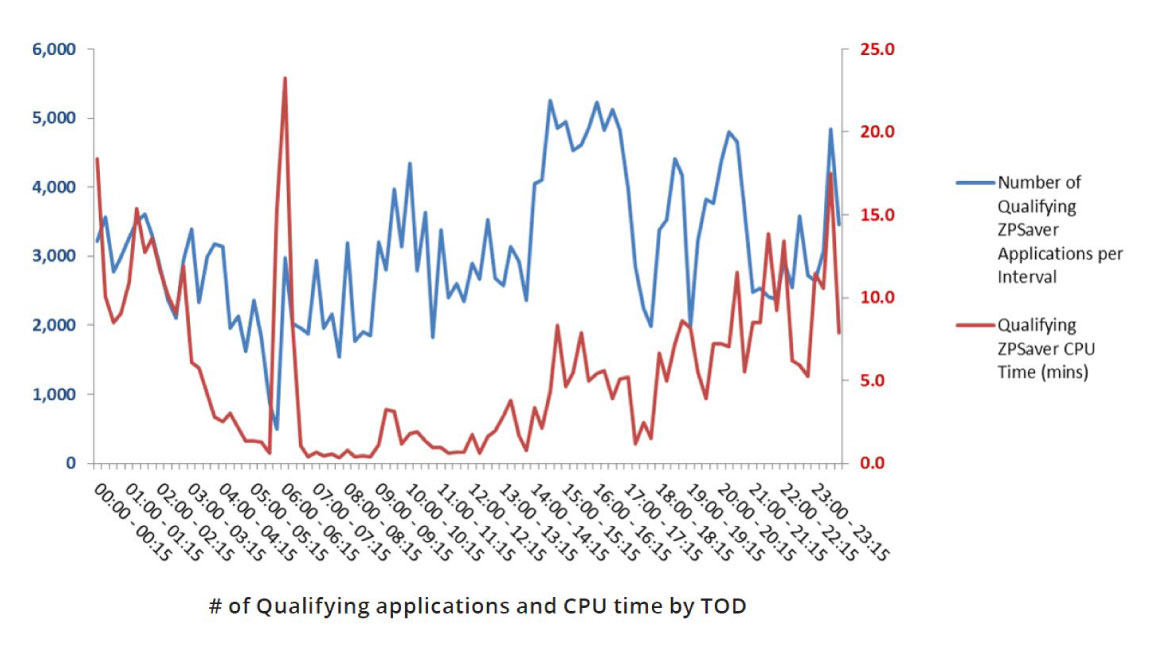eBook
ROI Strategies for IT Executives
Read this eBook to learn about additional challenges that organizations struggle with and suggest solutions on how to overcome them.
Introduction
In the 1996 movie Jerry Maguire, the character Rod Tidwell, played by Cuba Gooding Jr., was always challenging Jerry to “Show me the money!” That line is the modern day mantra of most CIO’s and C-level executives when dealing with IT staff, vendors, and suppliers as they constantly look for ways to increase their return on investment.
In the IT world, ROI can come in many different shapes and forms such as:
- Paying less for hardware, software, and IT services through tough contract negotiations
- Delaying purchases through more effective use of existing resources
- Increasing operational efficiency with better tools
- Maximizing the use of the existing infrastructure and not wasting unused capacity
- Ensuring that service level agreements (SLAs) are achieved so that critical IT services are delivered to customers as expected in order to protect the business
Putting contract negotiations aside for the purpose of this eBook, let’s look at some ways that organizations can get a better return on investment within their existing IT infrastructures.


Many organizations struggle with and face challenges around:
- Understanding how well existing resources are being optimized and how to best utilize them
- Determining the “right time” to budget and plan for additional resources
- Leveraging newer technologies to increase operational efficiency and increase ROI
- Empowering IT staff to be as efficient as possible
- Understanding and planning for increases in demand for capacity to ensure critical business services are delivered as expected
Highly distributed and complex IT infrastructures typically have many servers, in some cases too many, which are under-utilized. This can happen when servers are purchased to support high priority initiatives, and then no one monitors the usage to determine operational efficiency. In the worst case, the organization goes out and purchases additional capacity for one application, when in fact it has plenty of latent capacity left over from another application that could be re-deployed to delay an upgrade.
But, that’s just the open systems side of the IT infrastructure. What about the mainframe side of the house which tends to account for the largest part of the IT budget in most corporations? With the cost so high for IBM System z servers and software, organizations typically don’t end up in situations where processors go under-utilized. Or do they? Even in the IBM System z world, many organizations purchase specialty processors with the expectation that they will automatically take on workloads and increase processing capacity. But it simply does not happen, which results in a missed opportunity and wasted cost within the IT budget.
Then there is the whole issue of operational efficiency with the mainframe IT staff. It’s no secret that many organizations face the challenge of aging and retiring mainframe expertise leaving a knowledge gap and a requirement for the existing subject matter experts to do more to fill the gap.
Finally, the ongoing challenge that has faced mainframe IT organizations for decades – and still exists today – is how to get the most out of existing resources and ensure that mainframe services are being delivered efficiently to meet SLAs. So, let’s take a deeper look into two strategies that IT organizations can leverage to increase utilization of existing resources and enhance operational efficiency to increase their return on investment:
- Implementing processes and tools that would help manage and ensure more effective use of critical IT resources
- Leveraging the IBM System z Integrated Information Processor (zIIP) to relieve the general mainframe central processors usage and provide additional processing capacity for mainframe applications
Effective capacity management
Effective capacity management is an IT process that helps ensure that capacity meets current and future business requirements in a cost effective manner. Capacity management is extremely important in organizations where the overall cost of IT is skyrocketing. Many organizations today have distributed environments combined with a reliance on virtualization technology that can lead to considerable sprawl – a lot of systems with unused, excess capacity. Most IT teams face an obstacle to implementing processes and tools that would help manage the sprawl and ensure a more effective use of critical resources.
But, it doesn’t have to be that difficult. Capacity management is simply making sure you have the capacity for the business at all times, without it costing a fortune. Carrying out capacity management is very easy to do with an unlimited budget. But, who has unlimited budgets these days? This means that budget planning, monitoring, and reporting needs to be done to ensure that the processes are as efficient and cost effective as possible.
Here are some of the keys to effective capacity management:
- Monitoring the performance and throughput or load on a server or group of servers
- Performance analysis of key measurement data to understand patterns and anomalies that may impact service delivery
- Analysis of the impact of new applications on capacity
- Performance tuning to ensure the most efficient use of existing resources
- Understanding the demands on the service and future plans for workload growth (or shrinkage)
- Planning for and understanding Influences on demand for computing resources
- Capacity planning of storage, computer hardware, software, and connection infrastructure resources required over some future period of time

Syncsort™ Capacity Management enables an organization to take a proactive approach to implementing effective capacity management across the entire enterprise by identifying both over and underutilized resources, whether on premise or in the cloud, to provide a 360° view into IT services and infrastructure, helping lower costs and risk.
Capacity management: Analysis of disk space usage
A formal capacity management process can help save millions of dollars in IT costs. Here are some of the benefits provided by effective capacity management that can result in a significant return on investment:
- Predict when, how much, and what type of additional hardware resources will be needed, minimizing outages and cost to the business
- Ensure fewer outages occur due to capacity issues by meeting increased demand for service
- Provide predictive modeling to hypothetically change the IT environment and see the impact the changes will have
- Provide automated reporting facilities to help to significantly cut down on the amount of time it takes to generate and send performance and capacity reports to business units
- Make staff more productive by automating repetitive capacity management tasks and freeing up skilled personnel to do more valuable work
- Interfacing with existing framework data capture agents to leverage investment in existing framework tools
3 ROI use cases for capacity management
Governmental agency
Problem
A majority of the staff’s time, for the distributed capacity management, was spent collecting data, analyzing it, and producing manual reports
Solution:
Precisely’s Syncsort™ Capacity Management
- Distributed capacity management staff reduced the time spent creating reports to 10%, and were able to devote the rest of their time to growth strategy and other business critical functions. A side benefit was that no more tedious spreadsheets had to be produced by hand
Financial services organization
Problem
Experiencing unprecedented success – record business, strategic acquisitions, and continued growth into new markets, created a business risk for outages or performance slowdowns on critical services and the infrastructure that underpinned them
Solution:
Precisely’s Syncsort™ Capacity Management
- IT team was able to avoid over 100 Priority 1 outages, which the organization valued at $24M
- Saved $3.8M in overall IT spend, through lower maintenance, less power/cooling, and fewer hardware/ software licenses while receiving more effective utilization of existing resources
Governmental agency
Problem
Was facing a $320,000 expenditure for increased disk capacity
Solution:
Precisely’s Syncsort™ Capacity Management
- IT team was able to avoid the expenditure through effective analysis of utilization of existing disk capacity. Identified unused space and also a significant amount of data that had been created but infrequently referenced which could be moved to less expensive storage devices already existing within the infrastructure
Leveraging the IBM System z Integrated Information Processor (zIIP)
A variety of specialty processors have been incorporated into System z, allowing workloads which qualify, to execute on these special processors. When work is moved or offloaded to these special processors, the burden of general processors within the System z central computing complex is reduced providing additional capacity for standard workloads which do not qualify to run on the special processors.
An additional benefit comes in the form of software licensing, through the potential reduction of Monthly License Charges (MLC) for IBM software systems and packages. Once special processors are purchased, workloads executing on those processors run “free of charge” – cycles executed on the special processors are not included in the total execution capacity by which monthly license charges are imposed.
One of the most critical special processors is the System z Integrated Information Processor (zIIP). It was initially introduced to relieve the general mainframe central processors usage of specific Db2 workloads, but is currently used to o¢oad the general processor cycles of other IBM z/OS mainframe work.
Workloads must “qualify” to run on a zIIP processor, and unfortunately, not many do. This results in wasted capacity – special processors which have been purchased but go underutilized. One of the most CPU resource intensive, and highly used functions, in all IT environments is sorting. Virtually every application needs to sort data and copy information from one location to another
Syncsort™ ZPSaver is a high-performance sort, copy and join utility designed to exploit the advanced facilities of the z/ OS operating system and IBM z, including zIIP engines. It significantly reduces CPU utilization for sort operations, optimizes I/O activity to reduce contention, and leverages the use of zIIP engines to control software costs and delay/ prevent costly CPU upgrades.
Determining the potential ROI of zIIP o¢oad for sorting operations is relatively easy and very straight forward. All IBM z/OS mainframe sort operations, whether executed by IBM’s z/OS DFSORT or Precisely’s MFX, generate an SMF record. These SMF records can be easily analyzed to determine the ROI for zIIP offload using Precisely’s Syncsort™ ZPSaver. The analysis provides a summary of zIIP candidate workloads along with projected general processor utilization saving over a monthly and annual basis.
- Measure Sort and Copy processing TCB time and estimate the benefits of adding the Syncsort™ ZPSaver
- Report on resources consumed by Copy & SMS Compression
- List the most resource-intensive Sort and Copy steps
- Project the resource savings that can be achieved by using the Syncsort™ ZPSaver

3 ROI use cases for zIIP Offload
One of North America’s leading diversified financial services companies
- Analysis determined 95,000 SORT or COPY operations executing daily consumption of over 33,000 seconds of CPU time
- Syncsort™ ZPSaver provided 56% reduction in overall CPU consumption resulting in significant savings and freeing CPU resources for use by other workloads
- Increased use of underutilized zIIP engines
A major player and
global presence in the telecommunications sector
- At times hitting 100% of general processor capacity, seeing increases in monthly license charges, and facing a potential expensive CPU upgrade
- Syncsort™ ZPSaver provided 72.4% reduction in general processor CPU time for all sort workloads and helped avoid a processor upgrade
- Reduction in Millions of Service Units (MSUs) in the peak 4-Hour Rolling Average MSU consumption window used to determine monthly license charges for software
A major U.S. health
insurance provider
- Trying to delay and avoid a costly CPU upgrade by containing general processor CPU utilization
- Syncsort™ ZPSaver yielded CPU savings of over 6,000 minutes (100 hours) monthly and 72,000 minutes (1200 hours) annually
- Able to continue to operate the mainframe environment effectively with existing CPU capacity and have freed up hours of general processor CPU to be used by other workloads daily
Conclusion
ROI opportunities still exist for many organizations, and they can be found in places least expected – through better use of existing resources that have already been paid for within their IT budget. This typically results from advances in technologies which go unexploited and underutilized when existing processes and procedures simply are not updated to account for these technological advancements.
Although most organizations will claim to have some capacity management discipline in place, in reality it may not be as robust as what is needed to fully understand and leverage the resources within a complex and distributed IT infrastructure. Highly distributed IT environments with a reliance on virtualization technologies have ended up with considerable sprawl – a lot of resources going unused, underutilized or with excess capacity.

Attempting to manage capacity using outdated spreadsheets which are time-consuming to produce, require significant manual effort, and are prone to errors, simply is not effective. A formal and reputable capacity management process helps ensure capacity meets current and future business requirements in a cost effective manner. By simply assuring that your organization has the capacity it needs without over allocating or wasting resources – you can achieve the maximum efficiency from your IT infrastructure. Using Precisely’s Syncsort™ Capacity Management solution for effective capacity management could help save millions of dollars in IT costs! Many mainframe organizations have purchased the System z Integrated.
Information Processor (zIIP), but workloads must “qualify” to run on a zIIP processor, and unfortunately not many do. This results in wasted capacity – special processors which have been purchased but go under-utilized. The net effect is not only wasted capacity, but potentially increased costs in monthly software license charges, coupled with an inability to reclaim precious general processor CPU cycles for use by non-zIIP enabled workloads.
Syncsort™ ZPSaver
One of the most CPU resource intensive, and highly used functions, in all IT environments is sorting. Virtually every application needs to sort data and copy information from one location to another. These sort applications are prime targets for running on a zIIP processor. It’s a matter of identifying good candidates and enabling the sort activities to execute on a zIIP. Precisely’s Syncsort™ ZPSaver provides the tools needed to analyze the sorting environment to determine the CPU savings, and zIIP enables sorting operations to achieve those gains! With the Syncsort™ ZPSaver many organizations have saved hundreds of thousands of dollars in CPU and software license costs annually.